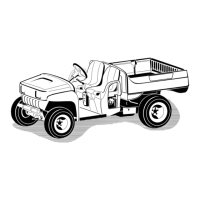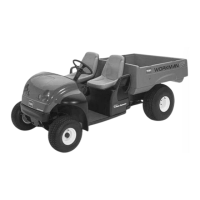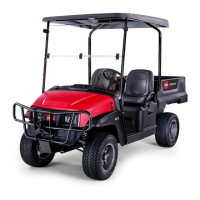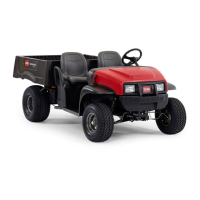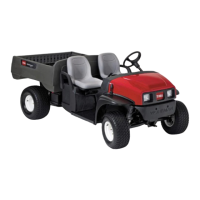the v ehicle is to tip o v er . Distribute the load as
lo w as possible , making sure that the load does
not affect rear visibility .
• P osition the w eight of the load ev enly from
side to side . If y ou position the load to w ard
one of the sides , the v ehicle is more lik ely to
tip o v er while tur ning .
• P osition the w eight of a load ev enly from front
to bac k. If y ou position the load behind the
rear axle , it will reduce the w eight on the front
wheels . T his ma y result in a loss of steering
control or cause the v ehicle to tip o v er on hills
or bumpy ter rain.
• Use extra caution if the load ex ceeds the
dimensions of the bo x and when handling
off-center loads that cannot be centered. K ee p
loads balanced and secure to prev ent them
from shifting .
• Alw a ys secure loads so that they do not shift.
If a load is not secured, or y ou are transpor ting
a liquid in a larg e container suc h as a spra yer ,
the load can shift. T his shifting happens most
often while tur ning, g oing up or do wn hills ,
suddenly c hanging speeds , or while dri ving
o v er rough surfaces . Shifting loads can cause
the v ehicle to tip o v er .
T he w eight of the bo x may be hea vy .
Hands or other body par ts could be
cr ushed.
– K eep hands and other body par ts
clear when lo w ering the bo x.
– Do not dump materials on bystander s.
• Nev er dump a loaded carg o bo x while the
v ehicle is sidew a ys on a hill. T he c hang e in
w eight distribution ma y cause the v ehicle to
o v er tur n.
• W hen operating with a hea vy load in the carg o
bo x, reduce y our speed and allo w for sufficient
braking distance . Do not suddenly apply the
brak es . Use extra caution on slopes .
• Be a w are that hea vy loads increase y our
stopping distance and reduce y our ability to
tur n quic kly without tipping o v er .
• T he rear carg o space is intended for load
car r ying pur poses only , not for passeng ers .
• Nev er o v erload y our v ehicle . T he decal
(located on the rear frame) sho ws load limits
for the v ehicle . Nev er o v erload the attac hments
or ex ceed the Gross V ehicle W eight (GVW).
Maintenance
• Before ser vicing or making adjustments to
the mac hine , stop the engine , set the parking
brak e , and remo v e the k ey from the ignition
to prev ent someone from accidentally star ting
the engine .
• T o mak e sure that the entire mac hine is in
g ood condition, k ee p all n uts , bolts , and screws
properly tightened.
• T o reduce the potential for fire , k ee p the engine
area free of ex cessi v e g rease , g rass , lea v es , and
accum ulation of dir t.
• Nev er use an open flame to c hec k the lev el or
leakag e of fuel or batter y electrolyte .
• If the engine m ust be r unning to perfor m a
maintenance adjustment, k ee p y our hands ,
feet, clothing, and any par ts of y our body a w a y
from the engine and any mo ving par ts . K ee p
ev er y one a w a y .
• Do not use open pans of fuel or flammable
cleaning fluids for cleaning par ts .
• If major re pairs are ev er needed or assistance
is required, contact an A uthorized T oro
Distributor .
• T o be sure of optim um perfor mance and safety ,
alw a ys purc hase g en uine T oro re placement
par ts and accessories . R e placement par ts and
accessories made b y other man ufacturers
could be dang erous . Altering this v ehicle in
any manner that ma y affect v ehicle operation,
perfor mance , durability , or its use , ma y result
in injur y or death. Suc h use could v oid the
product w ar ranty .
7

